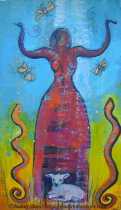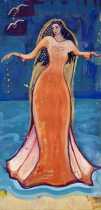
With all of the flooding in the world right now I thought now would be a good time to re-visit the story of Dahut, Breton Goddess of Love and Sexuality, whose city of Ys was destroyed by a flood.
Dahut Ahes, Breton goddess of Love and Sexuality is a Celtic Goddess whose origins are obscured by patriarchal tales which cast Her as wanton and depraved. By weaving together the tales as they are today with an understanding of the life-affirming nature of the old pagan ways Dahut emerges as more than a glittering goddess of beauty. She is revealed as an ancient goddess in a long line of goddesses holding the rebirth of the old ways in Her loving arms.
Her story begins with Her parents.Her father, Gradlon King of Brittany was originally Pagan but later converted to Christianity with the pressure of the times. Her mother, Malgven was believed by some to be a goddess of the Tuatha Dé Danann, the ancient deities of the Celtic world. Others believe Malgven to have been a Druid or a Sorcerer from the land of the Picts, the original inhabitants of Scotland.
On one of Gradlon’s campaigns in the North, they met and fell in love. But Malgven was married to the old King of Siaelland (Denmark). In the tradition of the ancient ways in which the old king dies, making way for the new, Malgven and Gradlon conspired to kill the old king. Then they fled together as King and Queen of Brittany on Morvac’h, Malgven’s magical horse, who blew fire from its nostrils and could ride across the sea.
The couple remained at sea for a year and a day, during which time Malgven gave birth to Dahut. Some versions of the story recount that Malgven died in childbirth. Others say that the time had come for her to return to the faery world. Legend records that before she disappeared she asked King Gradlon what he saw in their daughter.
“I see you,” he says.
“Then she will be ever thus,” she answers.
Malgven, Herself descending from a long line of Goddesses who upon hearing the call to return home passed the baton of the earthly mantle on to their daughters, now passed that lineage on to Dahut.
King Gradlon mourned the absence of Malgven and poured all of his love into his daughter. In their honor King Gradlon built a magnificent coastal city named Ys (Kêr-Is in Breton). It became an important trade center and the most beautiful city in the world.
As Ys was built below sea level it was protected by a massive wall with a tall floodgate. The floodgates were opened at low tide, allowing boats to enter and to leave. Gradlon wore the golden key, the only key, that controlled the floodgates around his neck at all times.
All versions of the story blame Dahut for the destruction of Ys. This is an old tale retold in many lands - the tale of how woman and her sexuality destroyed a city, a garden, a paradise, the world. But following the Way of the Goddess we can construct a different tale for Dahut.
Dahut grew to be a great beauty, just like her mother. She was sough after by many men. She loved life and all the gifts the goddess has bestowed on us. She loved her city, Ys, with its beautiful rooms, towers, gardens, temples, and courtyards.
Dahut is of the Sea, She rules that deep consciousness of our desire for life; for all the pleasures that life offers.
She loved Her people and wished only the best for them. Dahut, during her incarnation as daughter of Gradlon and Molgven, felt pain at seeing the joys of life denied and demonized by the priests of Christianity. The seasons had turned many, many times and the Ancient Ways of the Goddess were being overpowered by the New Religion, which increasingly adapted more and more flesh-hating, life denying ideas and practices.
As her foremothers had done, She sought her King, she sought the balance of the female and male principles. But every man who came before Her was mired in the new ways, full of violence and hatred, greedy and power hungry, deniers of life, haters of women. So every morning She sent each suitor away and her heart sunk further into sadness at the state of the world.
More and more madly with each passing day, Dahut and her people danced and sang, drank and made love, hoping to bring back balance, to bring joy back. Until finally one day Dahut could no longer bear the depravation, the loss of beauty, the loss of pleasure, the loss of happiness. Knowing, like only a destroyer goddess can know, that death always precedes rebirth, she knew the time had come to wipe the slate clean. She stole the golden key to the floodwater gate from her father. She opened the floodgate, calling on the Goddess and the waters of the sea to drown the city of Ys.
Her father rushed to save Her with his magical horse, the gift from Her mother. But in the end he yielded to the demands of the Christian priest, Guénolé who cried out for Gradlon to let Dahut drown. And so he let her go to the sea.
Yet the sea is from where she came and to where she was destined to return. She has passed the centuries in Her sunken city of Ys with Her people. There they practice the Old Ways, honoring life, honoring the natural world and loving each other. And there they wait until the world is ready for the rebirth of the Goddess Way.
Dahut, The Once and Future Goddess, holds the sacred ways of love, of sexuality, of spirit manifest in this physical world in Her heart, Her mind and Her soul. Call on Dahut when you need to reconnect with the beauty and joy of our physical lives.
My deck of Celtic Goddess Oracle Cards is ready for publication. You can pre-order on my Indiegogo campaign page. Check it out - Please share!
...






















